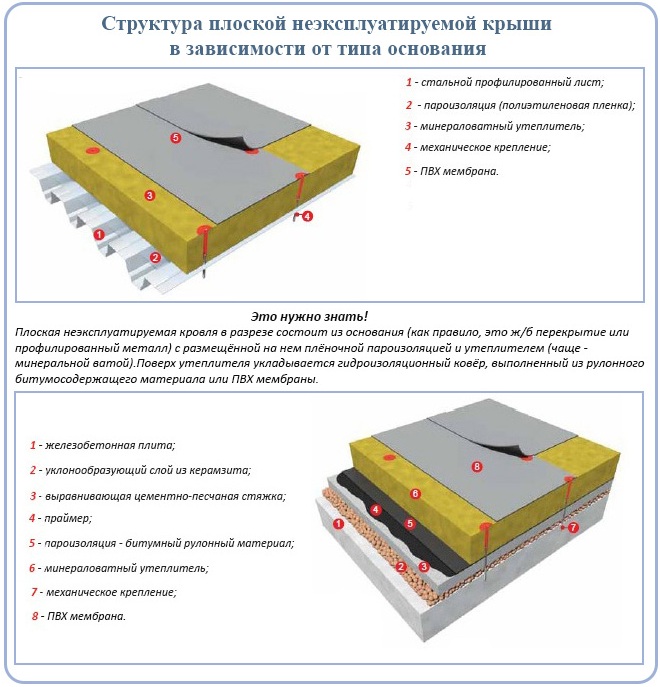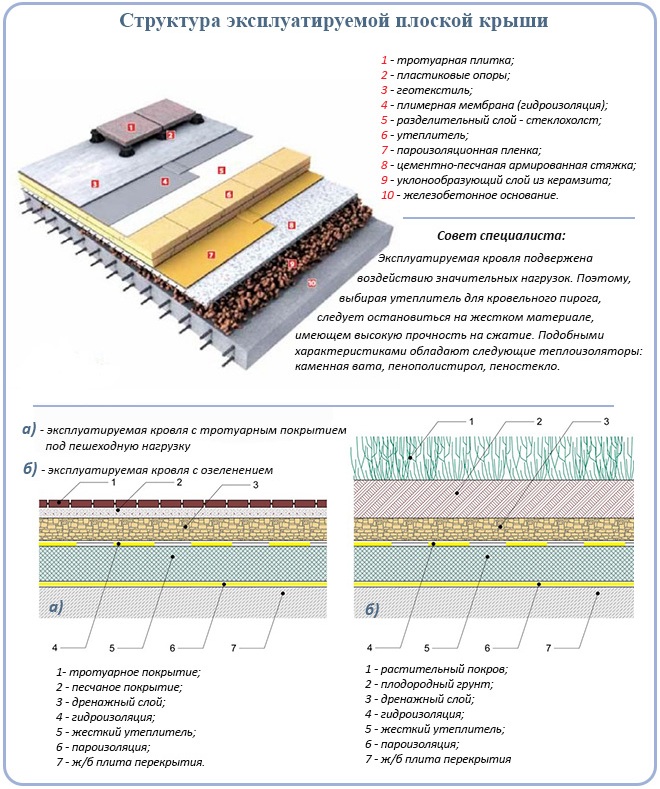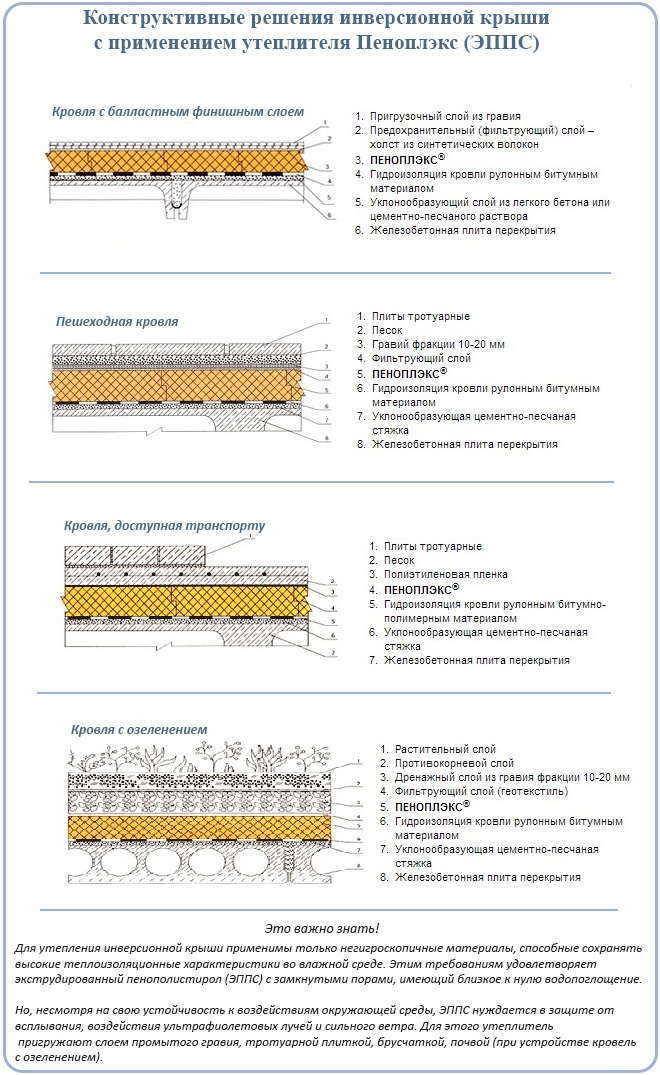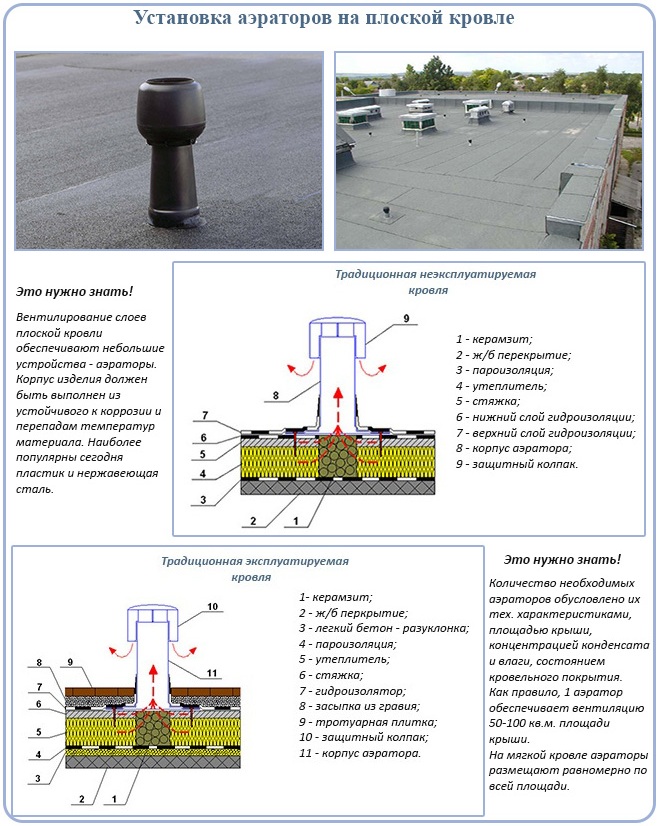More recently, a flat roof was considered the prerogative of monotonous city high-rise buildings and industrial buildings. Now the situation has changed. More and more private developers are resorting to this architectural solution, trying to increase the useful area of the house due to the arrangement on the roof of the terrace or viewing platform. An excellent prospect, is not it? But it can also become a real headache if the elements flat roof are picked up or located incorrectly, in violation of the technologies recommended by specialists. In order not to be trapped, we will understand the structures of flat roofs, their components and the layerwise distribution of elements.
Let's start with the basics. In fact, flat roofing only visually produces the impression of absolute horizontality. A slight bias still exists - 1-5 ° (1.7-8.7%). Visually and during operation, it is completely invisible, but it allows atmospheric precipitation to flow freely to the points of the catchment area - this is its main task.
Unlike the sloping analogs, the flat roof does not have a rafter frame and, in fact, is a horizontal overlap, resting on the walls of the building. Its feature is in the reinforced layers of heat and waterproofing, which are necessary due to the roofing with the surrounding environment.
The attractiveness of a flat roof for developers is based on the following advantages:
- Reduced price. Compared with pitched roof, flat analog has a smaller area, respectively, the cost of materials - below.
- Simplified installation and further maintenance. Arrangement of a flat structure is simpler than a pitched one, since it is easier to move along the horizontal plane than on an inclined one. For the same reason, the complexity of maintenance and maintenance of the roof itself and the devices (chimneys, fans, antennas, etc.) are not different.
- The possibility of obtaining additional usable area (with roofs in operation). The surface of a flat roof can easily be used as a terrace, a promenade and even ... a garden with a real lawn.
The main element of the flat roof is a solid base: reinforced concrete slabs, corrugated board or solid surface of boards, plywood, OSB, DSP (with roofing on wooden beams). The roofing itself is made of several layers. Their number, location in the construction and materials of production depend on the purpose of the roof and its type.

Types of flat roofs:
- Unexploited roof. The simplest, not carrying any additional functions, except to protect the premises from the influence of the environment. It is not used for arranging places for recreational or economic purposes. All that is required of it - a sufficient protective function, the ability to withstand snow and wind loads, as well as the weight of employees performing maintenance activities. That is, when building such a roof, the calculation is carried out on the fact that at the same time 1-2 people can stay on it, not permanently, but only for the time of maintenance and repair of the coating.
- Operated roof. It is equipped to perform some additional functions, except for the roofing itself. For example, on exploited roofs arrange sports grounds, terraces, parking, plant lawns and break flower beds.
- Inversion roofing. It is characterized by non-traditional placement of layers - heat insulating mats (EPS) are laid almost at the very top of the cake. Waterproofing is mounted under a layer of insulation. This solution helps to extend the life of the waterproofing coating, and accordingly the roof itself. Inversion roofs can be both operated (most often), and unexploited.
Structure of flat roof pie
Each type of flat roof has its own structural features, allowing the use of specific materials and arrange the layers in a certain sequence.
Unexploited classical roofing
The finishing layer of this type of roofing is a waterproofing coating: ruberoid, bituminous fused materials, polymeric membranes, roofing mastic. For a long stay of people and operation such a roof is not designed, and therefore the presence of protection of the waterproofing layer is not provided.

Also, it is not necessary to use thermal insulation. Depending on the availability of this layer, the unexploited roofs are divided into insulated and insulated.
The insulated roof contains in its structure a heat-insulating layer, protected by a vapor barrier (from the side of the base) and waterproofing (from the outside). Due to the availability of insulation, this type of roofing is used in the construction of many residential, civil and industrial buildings.
Layers of insulated non-exploited roof are placed in such a sequence (the scheme may vary slightly):
- base;
- vapor barrier;
- heater;
- waterproofing (roofing).
The basis of insulated underexploited roof is most often reinforced concrete slabs or metal profile, less often - a base of boards, OSB, DSP, plywood on wooden beams. If necessary, the base is supplemented with an inclined layer, which determines the direction of water flow from the roof. Slope is formed, as a rule, by loose materials, screed (concrete or expanded clay concrete).
A vapor barrier layer is installed on the base thus constructed, used to protect the heater from wet steam rising upwards from the side of the room. As a vapor barrier can be used polyethylene and polypropylene films, pergamene, ruberoid. Next are 1-2 layers of insulation materials ( mineral wool, foam, EPS), and above them - a waterproof carpet from bituminous materials or polymeric membranes.
Insulated unused roof is formed similarly, minus two layers - heat-insulating and vapor-insulating, which in this version are not needed.
Applied roofing layers:
- base;
- inclined layer (if necessary);
- roofing.
Operated Classical roofing
More complex construction. It differs from the previous version by the presence of an upper durable layer, which serves to equip an exploited site. Typically, for this use a paving slab, a terraced board, gravel or crushed stone.

The roof can be installed both above the garage and above residential building. Accordingly, this construction is insulated and insulated.
The widespread structure of the pie of the exploited insulated roof:
- base;
- inclined layer (if necessary);
- vapor barrier;
- heater;
- waterproofing;
- separating and filtering layer (geotextile);
- paving slabs for preparation.
One of the options for the insulated roofed roof (with detailed analysis of all elements) is shown in the video:
Insulated operating roof does not contain thermal insulation. Accordingly, the vapor barrier film for protection of a heater here also is not applied. In the rest - the structure is identical to the above option.
Inversion roofing
This is a special case of exploited and unexploited insulated roofs. In the classical roofing construction insulation is always covered with a waterproof barrier.
In the inversion roof, the layers are inverted. The waterproofing membrane is displaced under the heat insulator. If a waterproofing carpet protects a heater in an ordinary classical roof, then in the inverse "flip-flop" - all the way around. Thermal insulation layer protects waterproofing.
Such a solution makes it possible to circumvent one significant drawback of traditional roofing structures: rapid destruction of the waterproofing carpet from the influence of temperature changes, ultraviolet rays, atmospheric influences. Inverted roofs are free of this drawback, in their structure the life of the waterproofing carpet is much longer.

Layers of a flat roof of inversion type are placed in this order:
- base;
- inclined layer (if necessary);
- waterproofing;
- heater;
- drainage layer;
- geotextile;
- protective protective layer - gravel or gravel ballast, tile, terrace board, etc.
Device inversion roofing perform according to the following principle. First, a waterproof barrier is laid on the base, covered with a heater. Next comes drainage and geotextiles. The top layer performs a protective function, often it is made in bulk.
In the structure of the inversion roof, the vapor barrier is not used. Accordingly, the heater can suffer from steam coming from the interior. On top of the heater, too, is not covered by atmospheric precipitation (in traditional roofs, the waterproofing function, which in this version is hidden in the lower layer of the cake), is the protection function. Therefore, special requirements are imposed on the heater, in the first place - minimum water and vapor absorption. These characteristics are mats of extruded polystyrene (EPS) - they are most often used in the structure of inversion roofs.

Stages of the inversion roof device are shown in the training video from URSA:
Arrangement of gutter system
As it was said before, the flat roof is not absolutely horizontal, it has a slight slope (up to 5 °), which is used for gutter systems.
Slope is formed in several ways:
- If the base of the roof is a reinforced concrete slab, then the slowness is carried out with the help of backfilling materials (expanded clay, crushed stone, perlite), concrete and expanded clay screed, warming plates.
- If the roof is arranged on wooden beams, the slope is provided either by initial laying of the beams at a small angle, or by additional installation of logs of different thickness with a slope in the required direction.
- When used as the base of a profiled metal, its laying is initially carried out under the necessary gradient.
Slope is necessary for the equipment of watercourses, which can be internal and external.
When the internal gutter is installed, the slope is taken to the water intake funnels or fittings located on the roof surface. Their number and location depends on the area of the roof, the conditions of its operation, the amount of precipitation in a particular area. Typically, one funnel is mounted on 200-300 m 2 roof.
Inside each funnel a filter is mounted, preventing leaves, branches, small animals from entering the drain. To prevent freezing of water, some models of funnels are equipped with self-regulating thermal cables. They contribute to the unimpeded removal of atmospheric moisture even in winter, during thaws.
Internal drainage, as a rule, is used for large industrial buildings. In private construction, outdoor drainage systems have become more widespread. In this case, the slope leads from the center of the roof to the edges, and the drain holes (overflow windows) are set at the corners of the parapet along with the shower trays. It is recommended to supplement the similar system with heating cables, since in winter there is a possibility of icing of shower trays and overflow windows.

Ventilation elements of a flat roof
Inside the room, where people live or work, water vapor constantly accumulates. He rises to the ceiling, cooling condensed and accumulates in the under-roof space. Moisture damages all layers of the roof - wooden, metal and concrete. And accumulating in a heater - gradually reduces its properties, increasing the cost of heating.
In order for wet couples to leave the roof construction, ventilating devices are installed on the flat roof - aerators. They are plastic or metal pipes different diameters, covered from above with caps in the form of umbrellas.
On flat roofs, the aerators are evenly distributed over the entire area. It is recommended to put them in the highest points of the plane, where the plates of the insulation are joined. Typically, the installation of aerators is performed during the construction of the roof, but it is possible to do this during the repair. The main thing is that this measure will greatly increase the longevity of the roof and the warming material.

In conclusion, I want to note that all elements of the roof are equally important for its subsequent operation and, even if only one of them is unsuitable or will be absent, the entire layered structure will suffer. Therefore, the choice of the type and quality of the roofing pie set must be taken with all responsibility.
A flat roof is a roof with a slope of less than 3%. It is considered one of the most popular and in demand both in residential and industrial buildings. But most often flat roofing is used in the arrangement of shopping centers, high-rise buildings and other large buildings. An extensive choice of architectural features, low construction costs, and durability are the main advantages of houses with flat roofs.
The device of flat roofs
Landscaping of a flat roof
Green roofing This is a modern solution for owners of suburban and urban houses. nowadays it is gaining popularity both among homeowners and among designers and architects, because green roofs distinguish a house among surrounding buildings and, thus, attract the attention of others. Therefore, a house with such a roof can even become a "work of art". But for gardening fit only dense and resistant to the effects of the roots of the roof. An important requirement for the arrangement of green roofs is the ability to store rainwater, while excess water must be discharged in a timely manner. The substrate is selected taking into account the loads that the structure can withstand. The technology of gardening at first glance seems simple, but it's not so, because if you do not calculate the load correctly, it can not stand it. Therefore, self-gardening is not recommended, it is better to entrust this matter to specialists.
Advantages of flat roofs
Flat roofs in private construction are used extremely rarely, but still have a number of advantages. Here are the main ones:
- relatively low price of laying - the device of a flat roof will require less building materials, than for a pitched roof;
- simplicity of erection, maintenance and repair;
- possibility of installation on the roof of equipment, for example, air conditioners;
- the possibility of using the roof as an additional area, for example, for a sports ground, pool, garden.
Due to their advantages flat roofs are in demand both abroad and in Russia, despite, in most cases, their unattractive appearance. At present, the best representative of such roofs are inversion, since they are considered the most reliable and durable. The technology of the construction of such coatings is clearly worked out, so it will be easy to find specialists who will perform all the work qualitatively. If your choice still fell on a flat roof, you should approach with seriousness the procedure for its installation. If all the steps of the installation are carried out correctly, the roof will last you for many years and will protect your home from rain, snow and other troubles of nature. Good luck!
With the help of a flat roof in a private house, you can increase the useful area with natural lighting. This is the main argument in favor of creating a flat roof. On the roof you can make a lawn, a top terrace and more. Accompanies more and saves on materials and work on the creation of the roof, since it has a minimal area.
But a flat roof can only be created under the project. Increased strength is required not only from overlapping under the roof, but also from walls and foundation. The whole house should be designed for additional loads from water accumulation and snow accumulation, as well as from possible additional equipment on the roof. If a project of such a building is chosen, then it remains for small - to create a flat roof. Consider the main types and designs of flat roofs. What experience has been gained in their operation, and how best to make a flat roof.
Basic types of flat roofs
Flat roofing can be exploited and not operated.The first implies that you can always walk on it, you can store something on its surface, or even drive cars there (special construction).
An unused flat roof can be visited only for repair and inspection, and even moving around it is often possible only on the bridged bridges. Not exploited roofs are cheaper, they are more often used in high-rise economical construction of inexpensive buildings.

In the private sector, the exploited flat roof will most likely be in demand. In this case, the usual equipment on a flat roof - a small swimming pool, lawn, sun terrace and a light canopy nearby ....
Slopes and gutters
At the top of the roof there must be slopes towards the water intake funnels, which ensure the movement of water. The diameter, the location of the gutters, the construction of the water receivers and the whole gutter, and the slopes of the sectors (in different places of the roof) are determined by the project.
Freezing of water in drains should be prevented. The funnels are heated electrically. The ice cork in the drain can result in the accumulation of water on the roof above the permissible level. Emergency drainage holes are made in the fences.
The drainage pipe is usually laid inside the building, it is removed beyond its limits into the underground drainage system. 
Roofs are equipped with at least two water intake funnels (there can not in principle be more than 200 m of roof per funnel).
When building, it is important to observe the uniformity of the gradient without differences. Allowed not more than 10 mm by 2 meters along the slope and not more than 5 mm by 2 meters across, at angles of inclination of 1.5% or more.

The accumulation and stagnation of water due to unevenness of the coating leads to an accelerated destruction of the flat roof itself. From how exactly the configuration of the surface will be performed, the longevity of the roof will depend, and the convenience of its operation. Stagnant zones should not be. Minimum grade – 1,5%.
At a distance from the funnel by 0.5 meters, the angle of inclination of the roof should be at least 4%.

Usually the roof overlap is made horizontal concrete slab. The necessary elevations and gradients are formed by light bulk materials. They are manually leveled, the work is controlled by a laser builder.
By constructive features distinguish between traditional and inverted flat roofs. Let us consider these constructions in more detail.
Traditional constructions
Traditional provides such a sequence of layers in the roof cake from the bottom up:- podsypka which forms slopes;
- vapor barrier;
- heater;
- a strong screed (for roofs in use) or a fragile coating for not exploited;
- waterproofing wear-resistant layer.

A significant disadvantage of a flat roof made under this scheme is the rapid wear of the waterproofing coating. The duration of maintenance-free operation depends very much on the quality of the work performed, as well as on the quality of the top coating materials.
Another disadvantage is the possibility of accumulation inside a roofing cake
moisture that penetrates through the vapor barrier from inside the building and then condenses at a temperature drop, and also through any waterproofing impairments.
Special technologies were developed for the construction of such roofs in several layers with bitumen-roll coatings. A very complex and time-consuming process of covering the flat roof with bituminous roll coating is shown in the video. 
And the danger of internal water accumulation has even led to the creation of so-called breathing roofs, when ventilating pipes are installed in the insulation layer to dry it. This is the so-called breathing ventilated roof with the removal of steam from the heater.
Inverted flat roof
The inverted flat roof is devoid of the mentioned disadvantages. Its design usually includes the following layers:- podsypka - equalizer slopes;
- waterproofing;
- moisture resistant strong insulation;
- covering the insulation with an additional layer of waterproof film that protects the seams between the individual sheets;
- padding with wear-resistant coating;

For the top padding used the same materials as for pavements. It is completely impregnated with water, but then dries, as it is made of drainage materials. But the water does not penetrate the insulation layer. This option is well suited for a significant operation of the roof, when abrasion occurs due to exploitation, and not only because of the movement of water with abrasive particles.
Materials used
The padding with which the corners are formed is usually performed with lightweight materials - expanded clay or slag. Their surface under the vapor barrier is leveled additionally with a layer of sand up to 3 cm thick or thin not strong screed.As a vapor barrier, special membranes with increased strength properties are used.

For warming previously recommended and dense mineral wool. But according to the conditions of water accumulation, taking into account the possibility of using comparable extruded polystyrene foam and sprayed polyurethane foam, it has lost its relevance.

Actually, the development of new materials technologies, in particular the creation of extruded polystyrene foam and sprayed polyurethane foam, led to the possibility of creating an inverse, cheaper and durable roof. At the same time, the water-absorbent extruded polystyrene foam also perfectly resists all compressive loads.
Now it is usual in all types of flat roofs, it is recommended to use steam-proof and non-accumulating extruded polystyrene foam. A competitor is a high-density polyurethane foam sprayed onto it, which is more expensive by itself, but for large areas of insulation it becomes profitable due to a reduction in the laboriousness of the laying.
What should be the thickness of the insulation? For mineral wool in a moderately warm climate, the economically viable value is from 20 cm, for extruded polystyrene, respectively, not less than 15 cm, or according to heat engineering calculation.
The screed over the heater is made from conventional cement-sand mixture thickness of 3 cm without reinforcement at low intensity of operation, up to 5 cm with reinforcement. Its surface is leveled under the coating

It should be noted that bitumen-roll coatings for flat roofs in Western countries are now practically not used. They were replaced by more durable PVC membranes or EDPM membranes, as the best in terms of price-quality ratio. But since they have a much higher cost, we rarely use them - they still do not want to invest money in the future.
On the inverted roofs, usually a layer of insulation is sprinkled with sand up to 10 cm thick, on which pavement tiles are laid.
Geotextile is applied from above on a layer of a heater (above a waterproof film over a heater) as strengthening layer.
A grassy lawn is placed in place of paving slabs over geotextile.
As we see flat roofs - a great way to create an additional area in a dense urban environment. In Western countries, flat roofs are very common. They are gaining popularity with us.

